Military
Assault with a chocolate cream pie
1974: Seabee Leon L. Louie explained that the reason he hit his commanding officer in the face with a chocolate cream pie was to boost the morale of his battalion. However, the Navy failed to see the humor in what he had done and court-martialed him.Comedian Soupy Sales testified in Louie's defense, arguing that hitting someone in the face with a cream pie is comedy, not assault. Nevertheless, a jury of five officers found Louie guilty, though they gave him the lighter sentence of demotion, restriction to base, and a fine — rather than a dishonorable discharge.

Muncie Evening Press - Nov 26, 1974

Redding Record-Searchlight - Dec 6, 1974
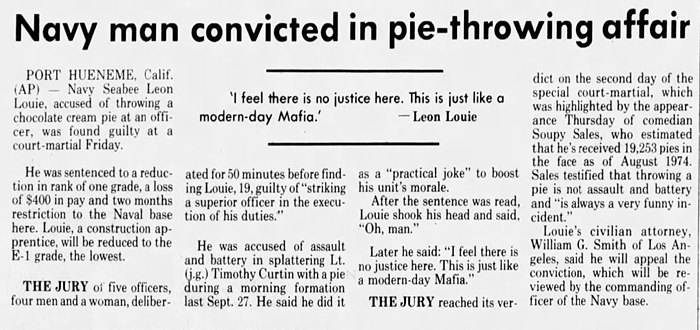
Tampa Bay Times - Dec 7, 1974
Posted By: Alex - Sun Feb 19, 2023 -
Comments (3)
Category: Military, Misbehavior, Rebellion, Acting-out and General Naughtiness, 1970s, Pranks
Midwatch In Verse
A new book explores the obscure poetic tradition of sailors in the U.S. Navy writing the first deck log of the new year in verse. As explained by the NW Arkansas Democrat-Gazette:The records, quasi-legal documents, were a requirement of each ship to note various bits of technical information -- ship speed and direction, even the number of propeller rotations and other things that would only be useful or make sense if you were in the Navy.
But one time of year, sailors were allowed to deviate from the benign record keeping and exhibit creativity with brief storytelling. During the first watch of the New Year, from midnight to 4 a.m., the Officer of the Deck could record in verse.
No one is sure when, or why this tradition began. The earliest known example (reproduced below) dates back to 1926, but the tradition was apparently already well established by then.
More info: midwatch-in-verse.com
| I stand on the deck at midnight As the clocks are striking the hour And I’ll keep the watch until morning To the best of my humble power. We are anchored in Pedro harbor Tho there isn’t much of a lee And why they call it a harbor Is something I never could see But our hook is in hole A seven And our center anchor chain Has forty-five in the hawse pipe And a very gentle strain. When we anchored our trusty leadsman Made a very careful cast Finding eight and a half good fathoms As the bugler blew the blast. And down below in the fire rooms Which the black gang ought to man The steam is blowing bubbles In number seven can. All the battleship divisions Swing nearby on the blue Except the West Virginia And the Mississippi too. The Senior Officer Present Floats peacefully in his sleep On the good ship California The guardian of the deep. At one fifteen Roskelly A pill rolling pharmacist’s mate Returned from his leave on schedule He’s lucky he wasn’t late. That’s all the dope this morning Except, just between us two If the Captain ever sees this log My gawd what will he do? E.V. Dockweiler, Ensign, U. S. Navy |

Posted By: Alex - Fri Jan 20, 2023 -
Comments (4)
Category: Military, Books, Poetry
Dogs in Uniform
For prices starting at around $400 (converted from £330), you can get an oil painting of your dog in uniform.No mention of cats in uniform, but I'm guessing that if you're willing to pay for it, they'd be willing to paint it.
More info: Fabulous Masterpieces


Posted By: Alex - Sat Jan 07, 2023 -
Comments (1)
Category: Art, Military, Dogs
GI Joe Trouble Shooter
The video is a hoot, what with a deranged bird and the famous "Kung Fu Grip." But I am also intrigued by the descriptions of the control panel buttons. Did the set come with labels so you could change the button names? I suspect not. So..."Washington" is a given. Stay in touch with HQ. "Code X7" is suitably mysterious. But "Jungle" and "Arctic" are ultra-generic, whereas "Burma" and "Tibet" are ultra-specific. Why those two countries anyhow? Commie (Cobra) hotspots?A page devoted to the toy.
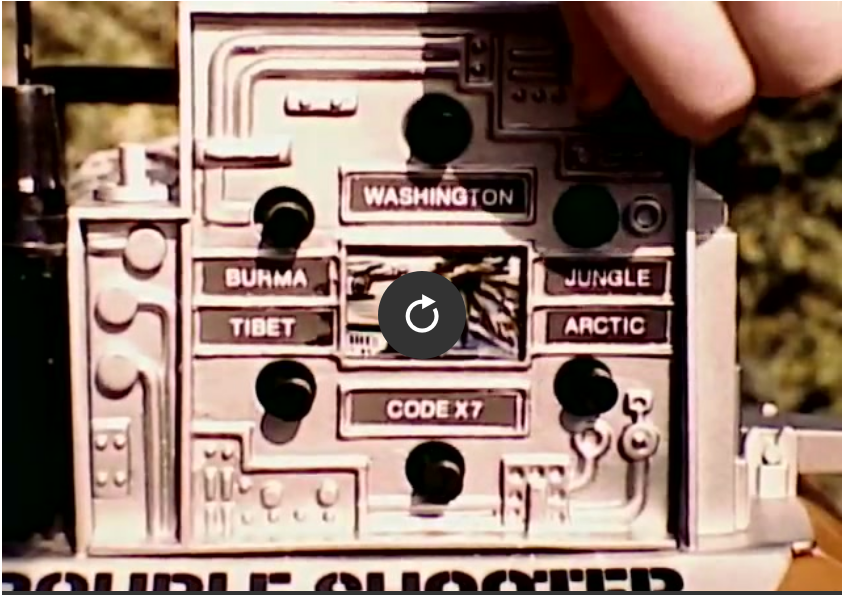
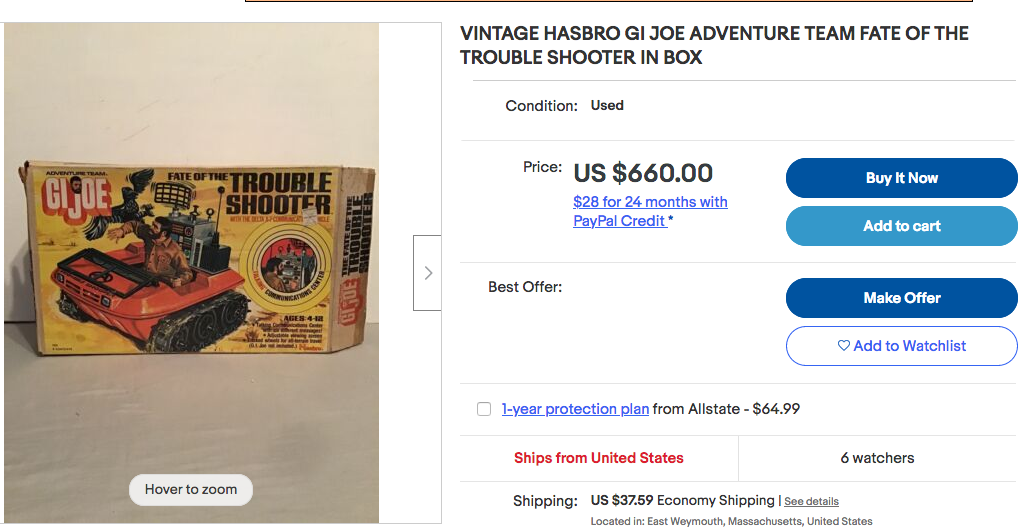
Posted By: Paul - Sat Sep 24, 2022 -
Comments (0)
Category: Animals, Military, Motor Vehicles, Toys, 1970s
Armored Shorts
According to info on quora.com, there's been a long, ongoing effort to develop armored shorts. However, soldiers inevitably find them uncomfortable, even though they appreciate the effort to protect their private parts.Such shorts are sometimes referred to as 'tactical diapers' or 'battle nappies'.
I like the detail that the armored shorts (below) developed during the Korean War were "capable of deflecting about 65 per cent of all missiles."


Louisville Courier-Journal - Dec 11, 1952
Posted By: Alex - Tue Sep 20, 2022 -
Comments (2)
Category: Fashion, Military, 1950s
Asleep in the deep with a jeep
A 1943 AP story about a jeep that traveled around the Pacific tied to a submarine became the centerpiece of an ad for ice cream the following year. The somewhat tenuous connection between the two was that the submarine crew eventually sold the jeep to a warship in exchange for three gallons of ice cream.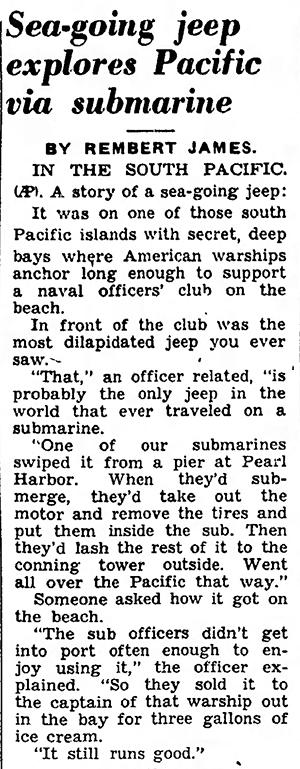
Nebraska State Journal - Aug 6, 1943

National Geographic - July 1944
Posted By: Alex - Fri Sep 16, 2022 -
Comments (0)
Category: Military, Advertising, 1940s, Cars
Personal Cleanliness
NOTE: stereotypical African cannibal imagery at end of film.
Posted By: Paul - Sat Aug 20, 2022 -
Comments (1)
Category: Hygiene, Military, Stereotypes and Cliches, 1940s
Braless at the asparagus banquet
1978: Hannelore Nelson was fired from her job as a translator with the U.S. Army in Germany for not wearing a bra while attending an asparagus banquet in Mainz, where she was translating for Gen. David Martin. At least, the General thought she wasn't wearing a bra. Nelson protested that she definitely had been wearing one, and she got the Mayor and Police Chief of Mainz to back her up ("Both said they saw nothing"). She eventually received $20,000 in compensation for wrongful termination.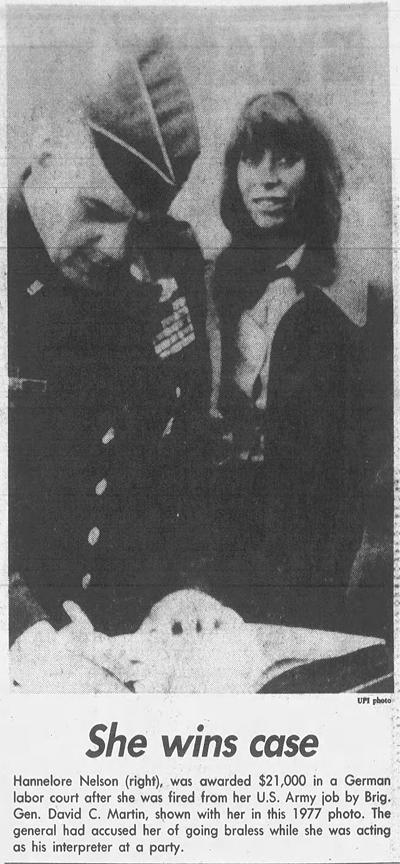
Oakland Tribune - May 31, 1978
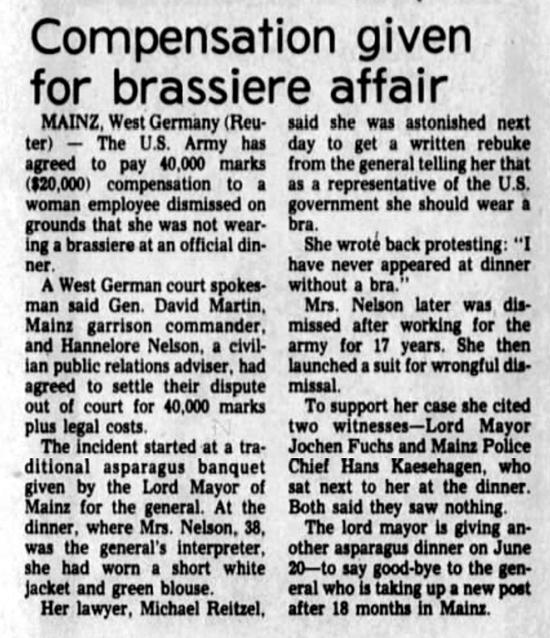
Red Deer Advocate - June 16, 1978
And in other Army brassiere news, the U.S. Army has recently developed a "tactical brassiere" which will be the first official uniform bra the Army has offered its female soldiers.
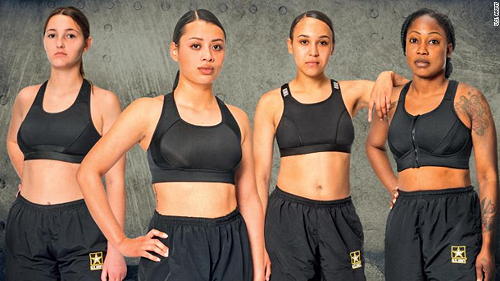
Posted By: Alex - Tue Aug 09, 2022 -
Comments (1)
Category: Military, Underwear, 1970s
Smelling the Enemy: The Odortype Detection Program
The U.S. Defense Advanced Research Projects Agency (DARPA) launched the "Odortype Detection Program" in 2002. It had two goals:The goal of Phase 2 will be to build a detector that can reliably detect the signature identified in phase 1 with high sensitivity and specificity.
By 2007, DARPA had changed the name of the program to the "Unique Signature Detection Program," but its goals remained essentially the same:
I haven't been able to find out what's become of the program since 2007. Though I'd wager that the U.S. government hasn't completely abandoned the idea since being able to identify people by their smell would be a hard-to-defeat surveillance technology. (Assuming that we all really do have a unique 'odortype' that can't be camouflaged with fragrance or by eating stinky food).
However, I did find a report on the program from 2005 that included the interesting detail that they field-tested the technology on seven sets of twins at Williamsburg, VA and Research Triangle Park, NC:
Posted By: Alex - Sun Jun 12, 2022 -
Comments (1)
Category: Military, Spies and Intelligence Services, Smells and Odors
Army Basic Training in Sound
Want to pretend at home that you've been drafted? Here you go!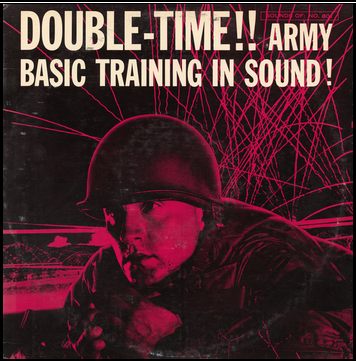
Posted By: Paul - Wed May 25, 2022 -
Comments (2)
Category: Military, Vinyl Albums and Other Media Recordings, Simulations, Make-Believe, Cosplay and other Pretend Situations, 1950s

| Who We Are |
|---|
| Alex Boese Alex is the creator and curator of the Museum of Hoaxes. He's also the author of various weird, non-fiction, science-themed books such as Elephants on Acid and Psychedelic Apes. Paul Di Filippo Paul has been paid to put weird ideas into fictional form for over thirty years, in his career as a noted science fiction writer. He has recently begun blogging on many curious topics with three fellow writers at The Inferior 4+1. Contact Us |




